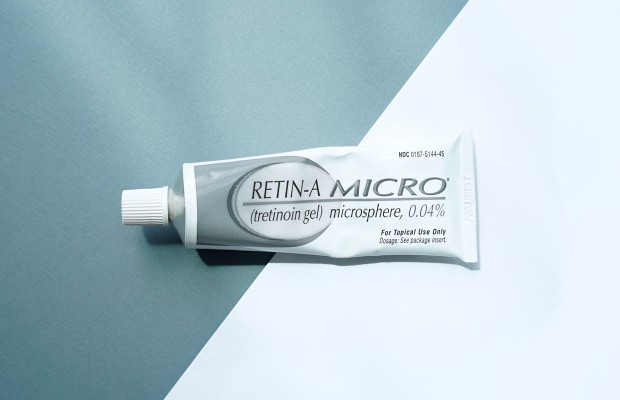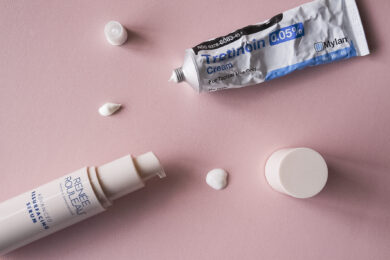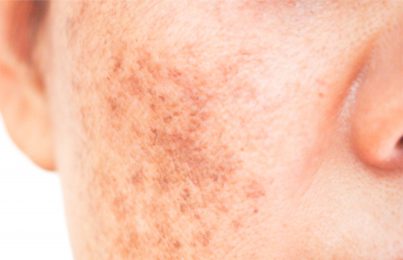This situation is all too common. You go to the dermatologist for help on how to improve your skin and she prescribes a tube of Retin-A or other retinoids like Retin-A Micro, Renova or Tazorac. She sings the praises of how it will transform your skin to become smoother, brighter and more even-toned with fewer blemishes. You eagerly start using it, only to find that despite following the instructions, you simply can’t put up with the side effects of dryness, peeling and continuous irritation. The intent is to make your skin look better, and now it’s only making it look worse. Sound familiar?
Out of frustration, you toss the tube in your drawer and the so-called “miracle cream” goes unused. Over time it will eventually reach its expiration date and your money was wasted. Well, I’m here to tell you not to give up because I’ve got a great way to use it to deliver some serious results.
For starters, a tube of prescription retinoid IS a miracle cream. I knew a dermatologist back in the late 80s who was instrumental in getting Retin-A FDA-approved for the treatment of wrinkles (previously it had only been used for clearing acne). Let me tell you, it works. I’ve seen it with my own eyes. Watch this video or read this post for the whole story. Trust me, it can truly turn back the clock on your skin and help manage clogged pores.
In a perfect world, you’d get back to using it again on a regular basis because maybe the first time around you didn’t quite use it per the instructions. Read my plan for how to use a prescription retinoid in a way that lessens the side effects and makes it more tolerable. It’s important to know that the dryness is just temporary, and you need to get past that to start getting results. Try following my instructions as I truly hope they work for you. If you’re still not sold on your prescription, using a non-prescription retinol is the best alternative for sensitive skin types that still want to see results. (It’s so very important to use a stable, well-formulated, time-released form of retinol which allows a slow release to the skin to prevent irritation.) Also, if you’re in your late 20’s and want to get started on retinol for preventative skin aging, a prescription is not always necessary since you may not have a lot of damage to reverse.
But at the very least, here’s a way to use it when you want the skin-smoothing, pigment-fading results similar to that of a light to medium-depth professional chemical peel—without the acid burn of traditional chemical peels. Because in theory, regular use of a prescription retinoid is like giving your skin mini peels over and over again since they both act as an exfoliating agent working deep within the skin to stimulate cell turnover.
To give your skin a peel at home, choose to do this when you don’t have anything public-facing going on, and you can handle a little skin down-time. Apply a generous layer of your retinoid onto clean skin at night. Normally, it’s recommended to use a pea-sized amount when used on a regular basis, but in this case, I’d up it to TWO pea-sized amounts. Next, leave your skin as is. Unlike how your derm may have suggested using it, you don’t want to apply moisturizer over it because you want it to work at full strength. The whole point is that your want your skin to peel, whereas when you’re using it on a regular basis (such as 2-3 times a week), the goal is to keep the dryness to a minimum so you can tolerate using it.
1-2 days after applying the cream or gel, the skin will start to feel tight and dry. For a few days after that, the skin should start shedding. At about day seven or eight, most of the visible peeling should be gone and you will now start to reveal the new healthier skin cells underneath. The skin will now be brighter, smoother and more even-toned—and you got a big collagen-making boost which is so good for aging skin. As an esthetician who performs chemical peels to my clients, I can tell you that the results can truly be amazing. The best part is, you choose when the time is right for you to do it.
To get optimal results, perform this retinoid peeling treatment once every 4-6 weeks. Then, use a non-prescription retinol 3-4 nights a week to regenerate cell turnover from within. Together, and with continued use, you’ll really start to see the miracle results that retinol and retinoids can deliver.
Lastly, you should be wearing sunscreen every day of the year no matter what. However, it’s particularly important to use it during and after this peeling process because those new cells are young and fresh and you don’t want to damage them with UV light. You must wear sunscreen even if you work inside all day. Read this post for more info.
Which skin care products are best for you? See our nine skin types or take the Skin Type Quiz and get products recommended.
Need expert advice from a licensed esthetician? Schedule a virtual consultation to get customized advice in person, over the phone or online via Skype or FaceTime.
For more expert advice check out the blog. Also sign up for our skin tip e-newsletter, follow Renée Rouleau on Twitter and Instagram and join the discussion on our Facebook page. You’ll be your own skin care expert in no time. Get the #ReneeRouleauGlow!
Celebrity Esthetician & Skincare Expert
As an esthetician trained in cosmetic chemistry, Renée Rouleau has spent 35 years researching skin, educating her audience, and building an award-winning line of products. Her hands-on experience as an esthetician and trusted skin care expert has created a real-world solution — products that are formulated for nine different types of skin so your face will get exactly what it needs to look and feel its best. Trusted by celebrities, editors, bloggers, and skincare obsessives around the globe, her vast real-world knowledge and constant research are why Marie Claire calls her “the most passionate skin practitioner we know.”




Comments:
Thank you so very much for this article. My skin just looks awful constantly on Retin-A but it loves peels! I’m going to try your method and use my general retinaldehyde in between times. Can you please advise on what’s best to use on my skin in the following 7-8 days? Thank you so much!
Posted By: Georgiana |
Hi
My weekly routine is 3 days of retinol and 1 day of tretinoin.
If i do this diy peel once every 4 to 6 weeks can i keep this weekly routine??
Posted By: Gracita |
I would suggest switching to a calming and hydrating serum the nights you plan on using any sort of peel and leaning on that more so throughout your peel week.
Posted By: Renée Rouleau |
Wow i wish the dermatologist i’d seen had told me even a fraction of what you explained about the tretinoin she prescribed me. I did see results and was happy my skin was looking and feeling better but i had to stop because of the painful dryness and crazy peeling that set off eczema and often further irritated my acne riddled skin. Thanks for the in depth explanation about how it works and how to use moisturizer with it. I will try and slowly integrate it back in my routine again.
Posted By: Leanne |
So happy to help. Thank you so much for reading!
Posted By: Renée Rouleau |
Hi there. Will this work for acne scarring especially on on the back, and shoulders?
Posted By: Theodorah Arthur |
Certainly! Since the skin on the back is tougher than the skin on the face perform the peel on a monthly basis and be careful to keep the treated areas protected with SPF and solar defending clothing.
Posted By: Renée Rouleau |
How soon after doing this peel can I use my regular retinol and exfoliating serum again? Should I take a few days off and just hydrate or continue my routine as normal the days following the peel?
Posted By: Precious |
Since you want to use a hydrating serum on the night you preform the peel you can continue your serum schedule from there. Use the exfoliating acid serum the day after the peel and retinol the following day. If you find your skin is feeling flaky or peeling skip a night of retinol or acid serum and use your hydrating serum in place as needed.
Posted By: Renée Rouleau |
Hi- Should I be moisturizing as usual (or more intensely?) while shedding my skin in the days after applying Tretinoin peel? Thanks!
Posted By: Christine |
I suggest using a hydrating serum, mask, and moisturizer when using Tretinoin. Instead of using a heavier moisturizer, hydrate in layers for the best results.
Posted By: Ella Stevenson |
How long do you apply the retin a ? For a few days or a week?
Posted By: Brittany |
Ideally, you would be using the retinol two or three nights a week. On the nights you skip retinol alternate a hydrating serum and an exfoliating acid serum for your skin type.
Posted By: Ella Stevenson |
Hi Renee
Can I use this Tretinoin DIY chemical peel method *as well as* using my prescription tretinoin cream 1 night a week?
I know you say to continue using a non prescription retinol 3-4 times during the week but I had hoped to continue using my 0.05 percent tretinoin cream 1 night a week as well as DIY method every 4-6 weeks.
Thank you!
Posted By: Sarah |
Hi Sarah! Yes, this is fine 🙂
Posted By: Renée Rouleau |